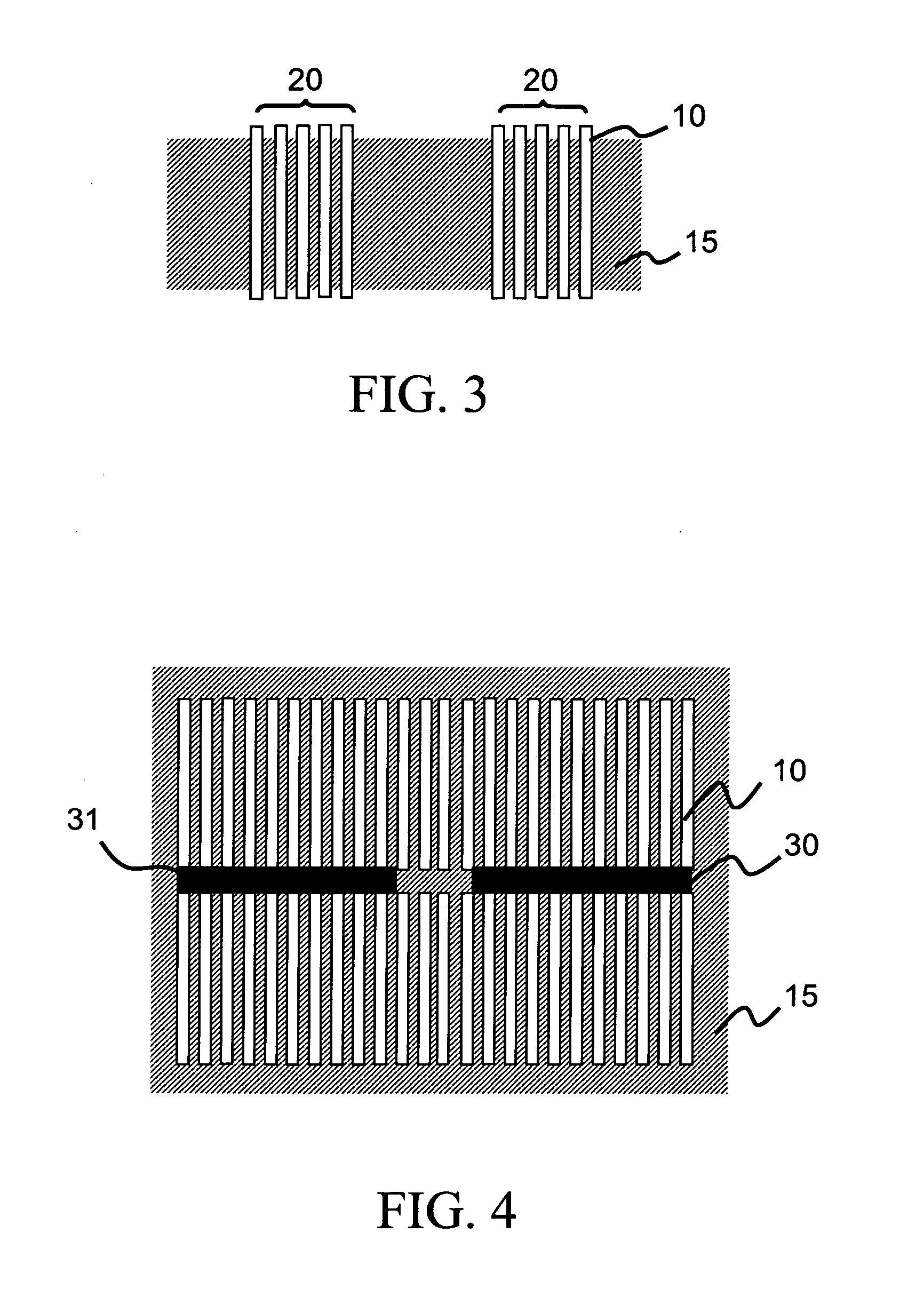Composite conductive film and semiconductor package using such film
a technology of composite conductive film and semiconductor package, which is applied in the direction of printed circuit manufacturing, printed circuit aspects, and nanoinformatics. it can solve the problems of unstable connection, disadvantage of two methods, and difficult filling of present underfill material into the spacing, so as to increase the strength of the 3d structure and high surface energy property
- Summary
- Abstract
- Description
- Claims
- Application Information
AI Technical Summary
Benefits of technology
Problems solved by technology
Method used
Image
Examples
first embodiment
[0049]FIG. 1 is a cross section view of the polymer conductive film. The polymer conductive film has a plurality of wires 10 that are separated parallelly and have a Z direction conductivity and a spacing less than 200 nanometer, and a polymer material 15 filled between the wires 10 by a method such as a diffusion process. The wires 10 can include a high conductivity material such as gold, silver, cobalt or nickel. The polymer material 15 can include a thermoset polymer material, which has a small Young's modulus, for example, an epoxy or a polyimide.
[0050] Then, the polymer material 15 located on one side or both sides of the polymer conductive film has at least one opening, and one end or both ends of most wires 10 are exposed by the opening. The opening can be formed by a dry etching pattening process, such as plasma etching, to remove the polymer material 15 that is located at the predetermined bonding position between the polymer conductive film and the chip.
[0051] The polymer...
fourth embodiment
[0054]FIG. 4 is a cross section view of the polymer conductive film. The polymer conductive film is used as an electric connection between the chips. The chip to chip electric connection can be achieved by connecting the two chips respectively to at least one end of the wires 10 of the polymer conductive film. The polymer conductive film has a plurality of wires 10 that are separated parallelly and have a Z direction conductivity, a plurality of conductive redistribution layers 30, 31 and a polymer material 15 filled between the wires 10 by a method, such as a diffusion process. The conductive redistribution layers 30, 31 are formed on the conjunction surface between the wire layers 10 and can be spaced at equal or random intervals along the conductive direction. The wires 10 can include a high conductive material, such as gold, silver, cobalt or nickel. The polymer material 15 can include a thermoset polymer material 15, which has a small Young's modulus, such as an epoxy or a poly...
third embodiment
[0063] In FIG. 10, the polymer conductive film of the semiconductor package shown in FIG. 3 is used for being an electric connection between the substrate 40 and the chip 50, where the two ends of the wires 20 are exposed on the two sides of the third embodiment's polymer conductive film (please refer to FIG. 3) for being the electric connection between the substrate 40 and the chip 50. However, the parts outside the electrodes 41 of the substrate 40 and outside the electrodes 51 of the chip need an adhesive dispensing process to connect them to the polymer material 15 for increasing the strength of the package.
[0064] In FIG. 11, the polymer conductive film of the semiconductor package shown in FIG. 5 is used for being an electric connection between the substrate 40 and the chip 50. There are an electric pattern and electrodes 41 that have a plurality of input / output with larger spacing on the substrate 40, where the input / output electricity connects to the electric pattern. The ele...
PUM
 Login to View More
Login to View More Abstract
Description
Claims
Application Information
 Login to View More
Login to View More - R&D
- Intellectual Property
- Life Sciences
- Materials
- Tech Scout
- Unparalleled Data Quality
- Higher Quality Content
- 60% Fewer Hallucinations
Browse by: Latest US Patents, China's latest patents, Technical Efficacy Thesaurus, Application Domain, Technology Topic, Popular Technical Reports.
© 2025 PatSnap. All rights reserved.Legal|Privacy policy|Modern Slavery Act Transparency Statement|Sitemap|About US| Contact US: help@patsnap.com



